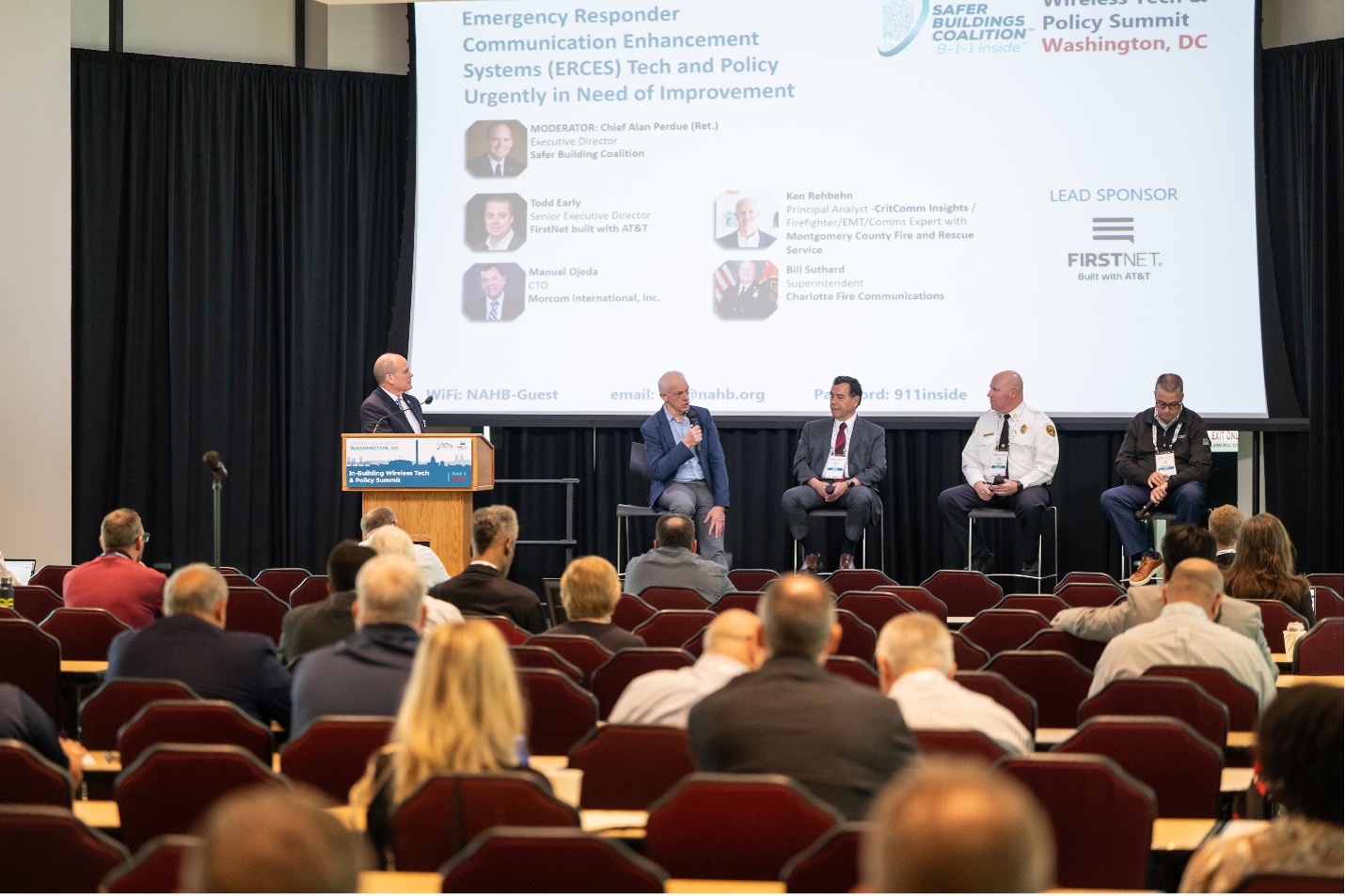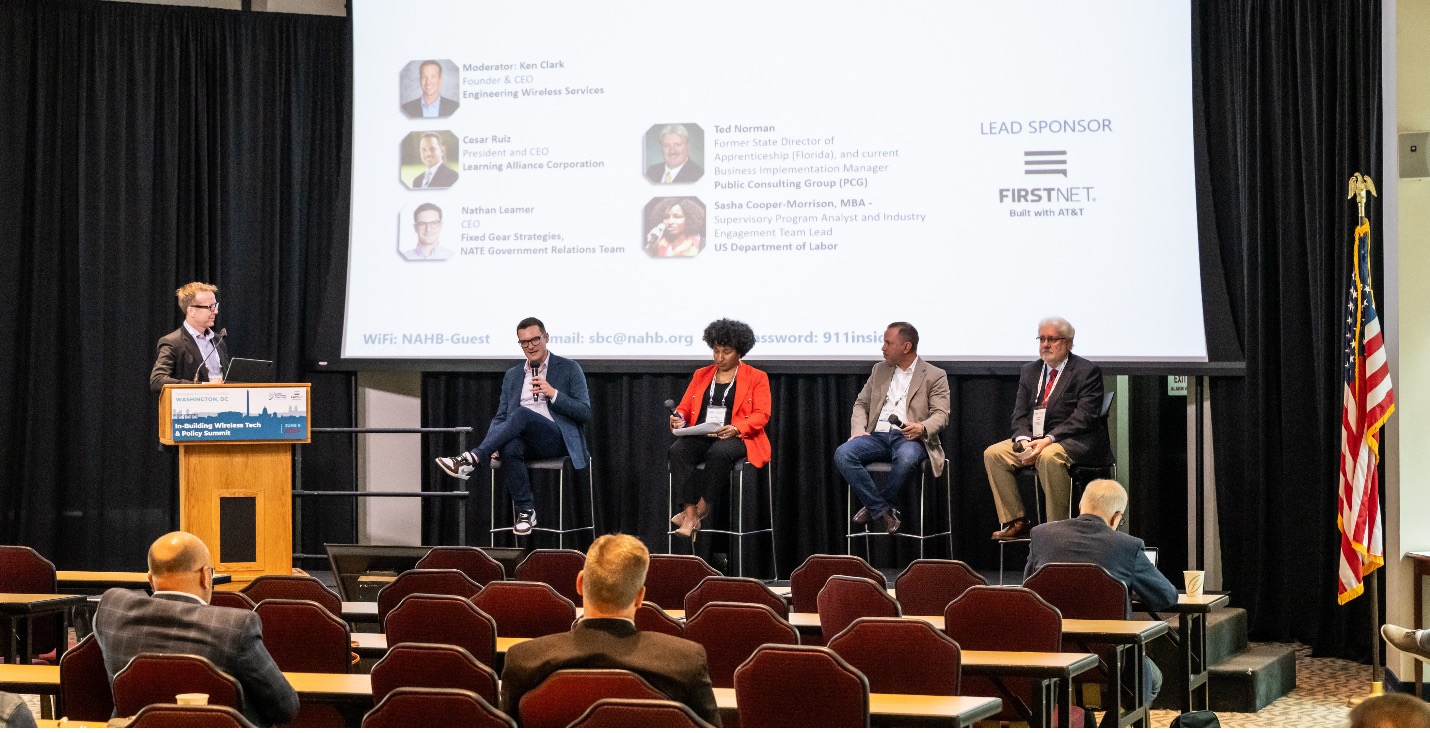Posted on July 18, 2024
By John Foley, Managing Director, Safer Buildings Coalition
The Safer Buildings Coalition is recognized as the definitive thought leader on the subject of in-building connectivity for public safety communications. We’ve worked hard to establish our credentials in this area, and we are poised to go to the next level to further advocate for ubiquitous connectivity inside buildings.
At our second annual In-Building Wireless Tech and Policy Summit, held June 6th in Washington DC, SBC went “beyond the code” and “beyond LMR” to really explore what it means to enable truly “safer buildings.”
From the Coalition’s very beginning, the SBC mission has embraced the Three Pillars of In-building Public Safety Communications:
- Mobile 9-1-1 Calls and Texts Must Get out With Location Accuracy
- Mobile Mass Notifications Must Reach Building Occupants
- First Responder Communications Must Work
Phase I of SBC’s journey -- the formative years of 2012 through 2017 -- set the table for the discussion as an idea crafted by Seth Buechley and leadership at SOLiD, with support from a handful of executives from other in-building vendors who had the community spirit and vision to imagine what such a coalition could accomplish.
Phase II of the SBC journey -- the building years from 2017 to 2023 -- saw the SBC become independent of any one company, grow in membership, scope, resources, stature, and impact.
Today, the SBC enjoys the support of over 130 industry companies, 20 Industry Association Knowledge Partners, 80 Public Safety agencies, more than 400 Individual Public Safety Members, 3 Work Groups, more than 100 volunteers, a strong Board of Directors, and commands a leading voice and input to the conversations put forth on the biggest event stages in the Communications Industry.
The capstone of SBC’s Phase II work was the publishing of the definitive reference on in-building wireless, our ERCES Handbook, which today has more than 2,500 copies in circulation. The book has been chosen to provide the testing basis for two major certifying bodies, with more to come.
As Seth Buechley stated recently – first at the SBC Annual Member’s Meeting and Dinner at IWCE in March, and later in more detail as he moderated the “9-1-1-Inside” Panel at our Tech and Policy Summit - SBC is now poised to Launch Phase III of our Mission Journey.
Phase III is the natural evolution that will enable us to embrace all three pillars of the SBC Mission with renewed energy, focus, resources, and aspirations for meaningful impact.
Where will SBC focus in Phase III?
SBC will concentrate on these objectives in Phase III
- Strengthen SBC’s team, infrastructure, and resources to build greater member value, and to enable a broader mission scope with wider impact
- Prepare for the continued growth and long-term viability of the SBC by bringing in strong new talent and leadership with fresh ideas
- Propel the trend towards “broadband first” and converged network technologies, advocate to maximize RF spectrum use and efficiency, drive acceleration of technology and workforce scale, and continue to combat harmful noise and interference that impact our public safety and commercial mobile networks
- Create four primary Domains of Focus and staff them with high-level leadership to drive impact on making buildings safer for first responders and occupants:
- School Safety: Prioritizing technology and connectivity solutions
- Enabling 9-1-1 Inside: Connectivity and Location Excellence
- Wireless Workforce Development: Curriculum, Training, and Certification
- Global Participation: Evangelize the mission, drive global standards, bring back global best practices
Wireless Tech and Policy Summit Sessions Launch the Conversations
The sessions highlighted in the next section shined a spotlight on these topics, bringing A-List thought leaders to the table to get the discussion going [Full Conference Program can be reviewed HERE].
In the coming months, we will be sharing video recordings and insights from the Summit in our newsletters and social media stories to keep the momentum and the conversations going.
There’s never been a better time to find out where the sector is headed, or to join our Community of Practice to help shape the technology roadmaps, best practices, codes, standards, and policies that will shape what it means to be Safe Inside for decades to come.
Click the link below to become part of the Mission.
Join Us!
9-1-1 Inside: A Call to Action
[CLICK PLAY BUTTON TO WATCH VIDEO]
The FCC estimates that a one-minute improvement in 9-1-1 response time would save 10,000 lives in the US. in a phrase: Time Is Life. At our 2024 Member's Meeting and Dinner at IWCE in March, SBC Founder Seth Buechley announced a bold Safer Buildings Coalition Call to Action: Setting the expectation that calls and texts to emergency services initiated from inside buildings should always get through, with clarity and accurate location. We have adopted the rallying cry: 9-1-1 Inside.
Implicit in this call to action are some key ideas:
- Solutions and the Workforce must scale to provide ubiquitous in-building connectivity – currently both technology and the workforce are overmatched by the scope of the problem
- A technology-agnostic approach is needed to drive down cost and increase scalability – including self-deployed solutions
- Solutions should both drive and leverage global standards to maximize interoperability, economies of scale, and to attract innovation and investment
- The business model must also be innovated – including market-driven and Public-Private Partnership (PPP) frameworks
- “Broadband First” and convergence technology roadmaps are key to achieving the biggest impact
- Solutions should be integrated “end to end,” meaning solutions must encompass 9-1-1 caller / incident origination, to NG 9-1-1 Emergency Communications Center, to Responding Agencies
School Safety and the Critical Role of Wireless Connectivity

While it is the role of many to find every solution that could make our schools safer, it is the role of the Safer Buildings Coalition and the wireless ecosystem to examine how public safety communications failures have been a factor in mass-casualty incidents, and how we must work to improve or eliminate such problems wherever possible. This session explored state and federal legislation (such as ALYSSA'S LAW) that offer help to schools to ensure that critical communications are always available inside school buildings during emergencies.
Read more about Alyssa’s Law and School Safety HERE
Emergency Responder Communication Enhancement Systems (ERCES) Tech and Policy Urgently in Need of Improvement

ERCES have an essential role in solving for the in-building wireless dead zones that hamper public safety communications. While the rapid growth of ERCES deployments across the country are helping to solve this problem, there are growing pains, leaving some asking: “Is the cure worse than the initial problem?” This session examined the current state of ERCES tech and policy and discussed what changes to both are urgently needed.
Building the Wireless Workforce

SBC estimates that there are more than one-million commercial buildings in the US that have inadequate in-building wireless coverage for cellular or public safety communications (or both). If we were to deploy in-building wireless infrastructure inside 10,000 buildings per year, it would still take us 100 years to address this lack of coverage. Simply put: The current wireless workforce, and the technology available to them, cannot scale to the challenge of eliminating in-building wireless dead zones. This panel explored training, certification, apprenticeship programs, and the gaps in competency, policy, and funding that must be solved.
Industry must be competent and scale to the demand. Both building owners and jurisdictions must have access to competent contractors and be able to confidently distinguish competent contractors from “trunk slammers” through a standards-based certification framework.
SBC has written a position paper on the need for certification of individuals. You can read about this position and download the paper HERE.
Share this Article